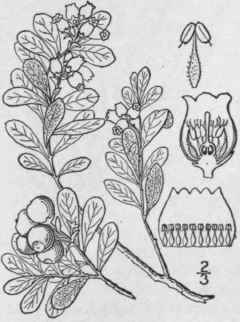23. Uva-Ursi Mill. Gard. Dict. Abr. Ed. 4. 1754. [Arctostaphylos Adans. Fam. Pl. 2: 165. 1763.]
Description
This section is from the book "An Illustrated Flora Of The Northern United States, Canada And The British Possessions Vol2", by Nathaniel Lord Britton, Addison Brown. Also available from Amazon: An Illustrated Flora of the Northern United States, Canada and the British Possessions. 3 Volume Set..
23. Uva-Ursi Mill. Gard. Dict. Abr. Ed. 4. 1754. [Arctostaphylos Adans. Fam. Pl. 2: 165. 1763.]
Erect or spreading, low or tall shrubs (some western species small trees). Leaves alternate, petioled, firm or coriaceous, persistent, evergreen. Flowers small, nodding, bracted, pedicelled, white or pink, in terminal racemes, panicles or clusters. Calyx 4-5-parted, persistent. Corolla globose, ovoid, urceolate or oblong-campanulate, 4-5-lobed, the lobes recurved, imbricated in the bud. Stamens 10, rarely 8, included; filaments short, subulate; anthers short, erect, introrse, with 2 recurved awns on the back, the sacs opening by a terminal pore. Disk 8-10-lobed. Ovary 4-10-celled; ovules solitary in the cavities; style slender. Fruit a drupe, with 4-10 seed-like nutlets coherent into a solid stone. [Greek, bear-berry.]
About 40 species, the following typical one of the northern hemisphere, the others of western North America.

1. Uva-Ursi ┘va-┘rsi (L.) Britton. Red Bearberry. Kinnikinic
Fig. 3249
Arbutus Uva-Ursi L. Sp. PI. 395. 1753. Arctostaphylos Uva-Ursi Spreng. Syst. 2: 287. 1825.
Trailing or spreading on the ground, branched; branches 6'-24' long, the twigs puberulent. Leaves spatulate, coriaceous, obtuse, entire, evergreen, glabrous or minutely puberulent toward the base, 1/2'-1' long, 2"-5" wide, finely reticulate-veined; petioles about 1" long, puberulent; flowers few in short racemes; pedicels 1"-2" long; corolla ovoid, constricted at the throat, white, about 2" long; drupe globose, red, glabrous, insipid, rather dry, 3"-s" in diameter, usually containing 5 coalescent nutlets, each 1-nerved on the back.
In dry, sandy or rocky soil, Labrador and arctic America to Alaska, south to southern New Jersey, Pennsylvania, Illinois, Missouri, Nebraska, Colorado and California. Also in northern Europe and Asia. May-June. Mountain-box. Universe-vine. Rapper-dandies. Fox- or meal-plum or -berry. Bear's-grape-bilberry or -whortleberry. Rock- or crow-berry. Barren myrtle or bilberry. Mountain, upland, wild- or hog-crawberry. Barren myrtle. -
Continue to:


